Organisational Behaviour Article Critique: Motivation and Efficiency
VerifiedAdded on 2019/10/31
|6
|1872
|185
Report
AI Summary
This report offers a critical analysis of an article focusing on organisational behaviour, exploring the crucial role of employee motivation in enhancing workplace efficiency and productivity. The report delves into various motivation techniques, including the application of economic tools, statistical methods, and management strategies to improve employee performance and achieve organisational goals. It discusses the strengths and weaknesses of the article's approach, highlighting the significance of motivation in unlocking hidden talents and satisfying employee needs. Furthermore, the report examines the practical implementation of motivational theories, such as Maslow's hierarchy of needs, and the impact of incentives, recognition, and self-motivation on employee outcomes. The analysis emphasizes the importance of tailored motivational strategies, considering individual differences within the workforce, and concludes that effective motivation is a critical factor in driving employee productivity and achieving organisational success. The report also references several academic sources to support its arguments.
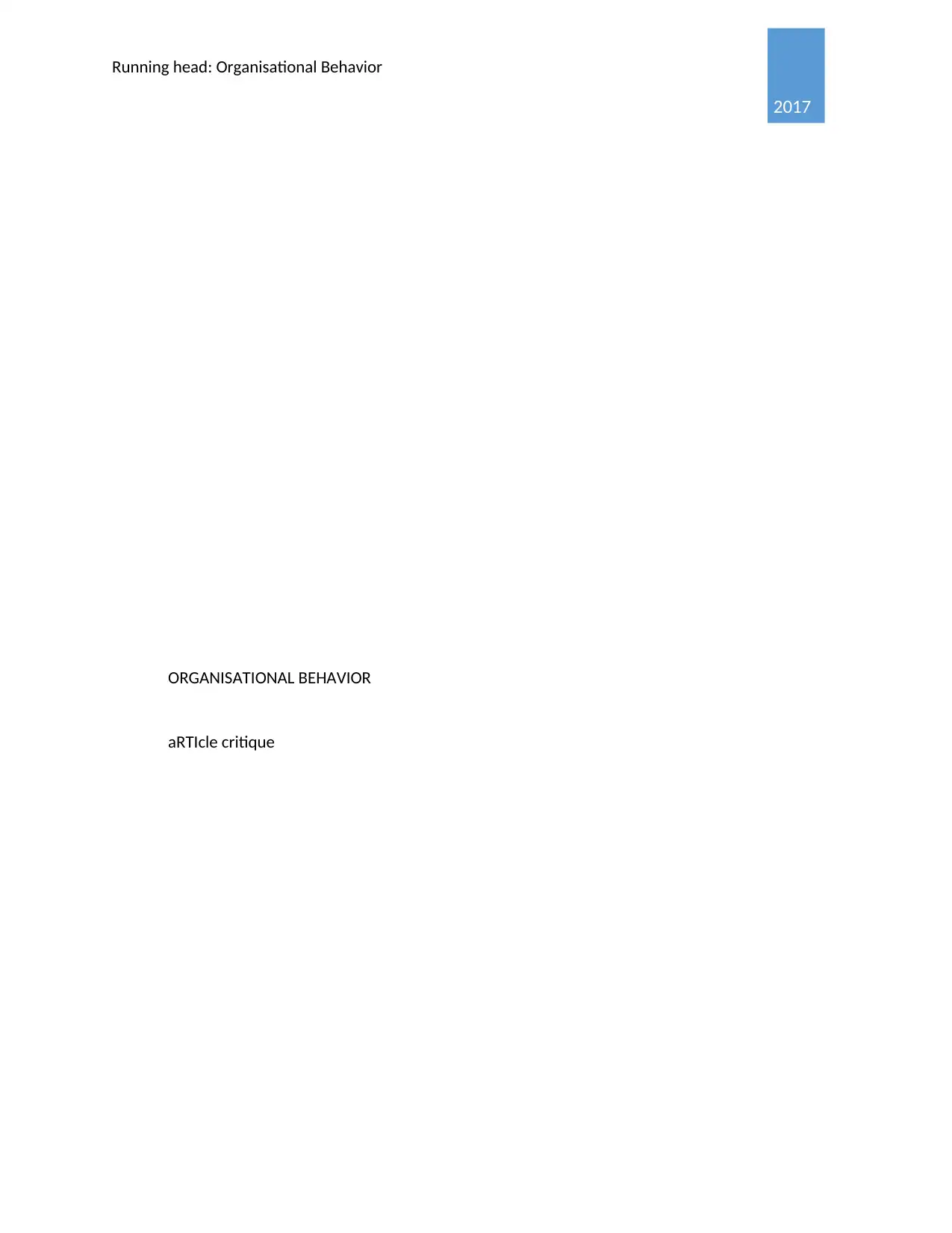
Running head: Organisational Behavior
2017
ORGANISATIONAL BEHAVIOR
aRTIcle critique
2017
ORGANISATIONAL BEHAVIOR
aRTIcle critique
Paraphrase This Document
Need a fresh take? Get an instant paraphrase of this document with our AI Paraphraser
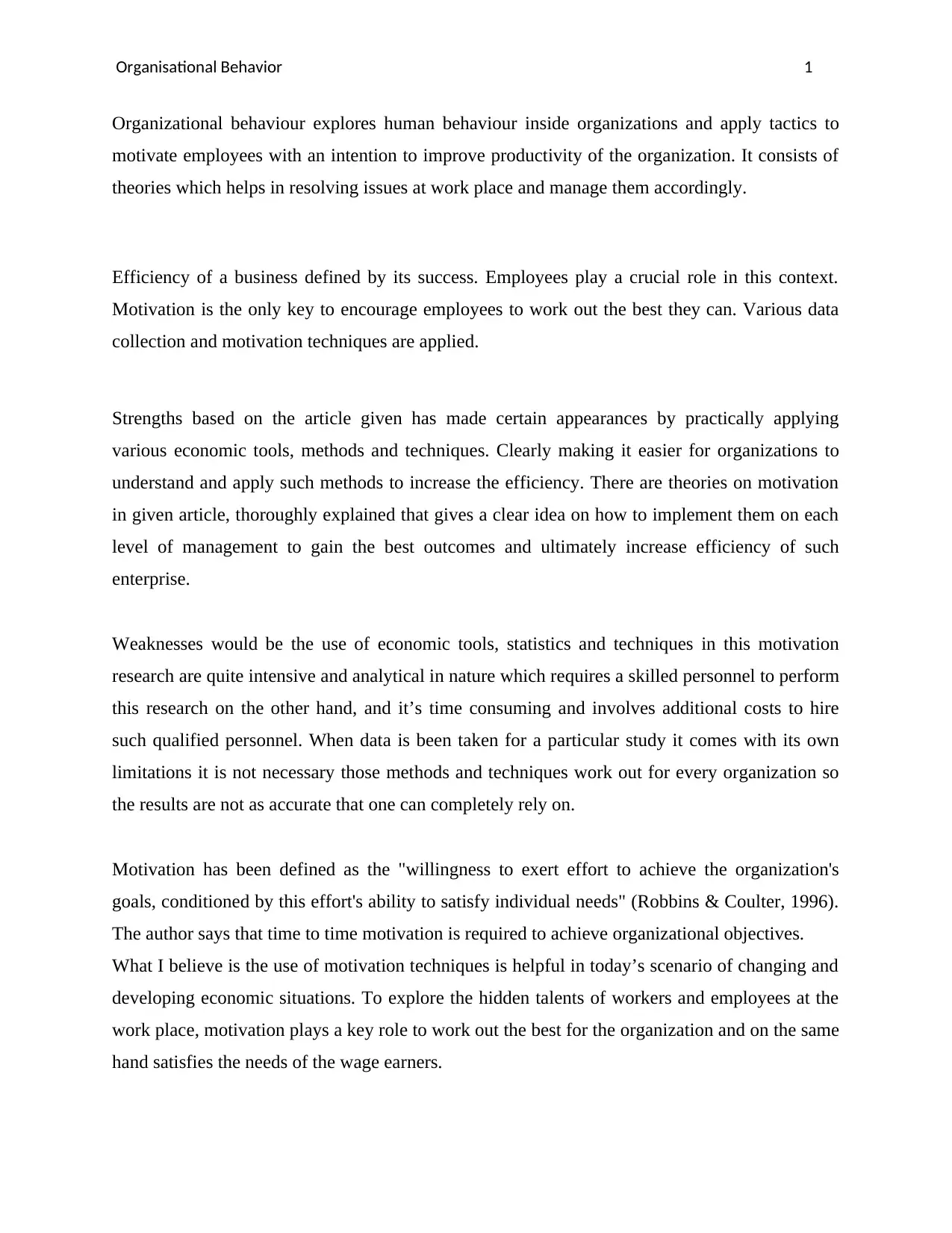
Organisational Behavior 1
Organizational behaviour explores human behaviour inside organizations and apply tactics to
motivate employees with an intention to improve productivity of the organization. It consists of
theories which helps in resolving issues at work place and manage them accordingly.
Efficiency of a business defined by its success. Employees play a crucial role in this context.
Motivation is the only key to encourage employees to work out the best they can. Various data
collection and motivation techniques are applied.
Strengths based on the article given has made certain appearances by practically applying
various economic tools, methods and techniques. Clearly making it easier for organizations to
understand and apply such methods to increase the efficiency. There are theories on motivation
in given article, thoroughly explained that gives a clear idea on how to implement them on each
level of management to gain the best outcomes and ultimately increase efficiency of such
enterprise.
Weaknesses would be the use of economic tools, statistics and techniques in this motivation
research are quite intensive and analytical in nature which requires a skilled personnel to perform
this research on the other hand, and it’s time consuming and involves additional costs to hire
such qualified personnel. When data is been taken for a particular study it comes with its own
limitations it is not necessary those methods and techniques work out for every organization so
the results are not as accurate that one can completely rely on.
Motivation has been defined as the "willingness to exert effort to achieve the organization's
goals, conditioned by this effort's ability to satisfy individual needs" (Robbins & Coulter, 1996).
The author says that time to time motivation is required to achieve organizational objectives.
What I believe is the use of motivation techniques is helpful in today’s scenario of changing and
developing economic situations. To explore the hidden talents of workers and employees at the
work place, motivation plays a key role to work out the best for the organization and on the same
hand satisfies the needs of the wage earners.
Organizational behaviour explores human behaviour inside organizations and apply tactics to
motivate employees with an intention to improve productivity of the organization. It consists of
theories which helps in resolving issues at work place and manage them accordingly.
Efficiency of a business defined by its success. Employees play a crucial role in this context.
Motivation is the only key to encourage employees to work out the best they can. Various data
collection and motivation techniques are applied.
Strengths based on the article given has made certain appearances by practically applying
various economic tools, methods and techniques. Clearly making it easier for organizations to
understand and apply such methods to increase the efficiency. There are theories on motivation
in given article, thoroughly explained that gives a clear idea on how to implement them on each
level of management to gain the best outcomes and ultimately increase efficiency of such
enterprise.
Weaknesses would be the use of economic tools, statistics and techniques in this motivation
research are quite intensive and analytical in nature which requires a skilled personnel to perform
this research on the other hand, and it’s time consuming and involves additional costs to hire
such qualified personnel. When data is been taken for a particular study it comes with its own
limitations it is not necessary those methods and techniques work out for every organization so
the results are not as accurate that one can completely rely on.
Motivation has been defined as the "willingness to exert effort to achieve the organization's
goals, conditioned by this effort's ability to satisfy individual needs" (Robbins & Coulter, 1996).
The author says that time to time motivation is required to achieve organizational objectives.
What I believe is the use of motivation techniques is helpful in today’s scenario of changing and
developing economic situations. To explore the hidden talents of workers and employees at the
work place, motivation plays a key role to work out the best for the organization and on the same
hand satisfies the needs of the wage earners.
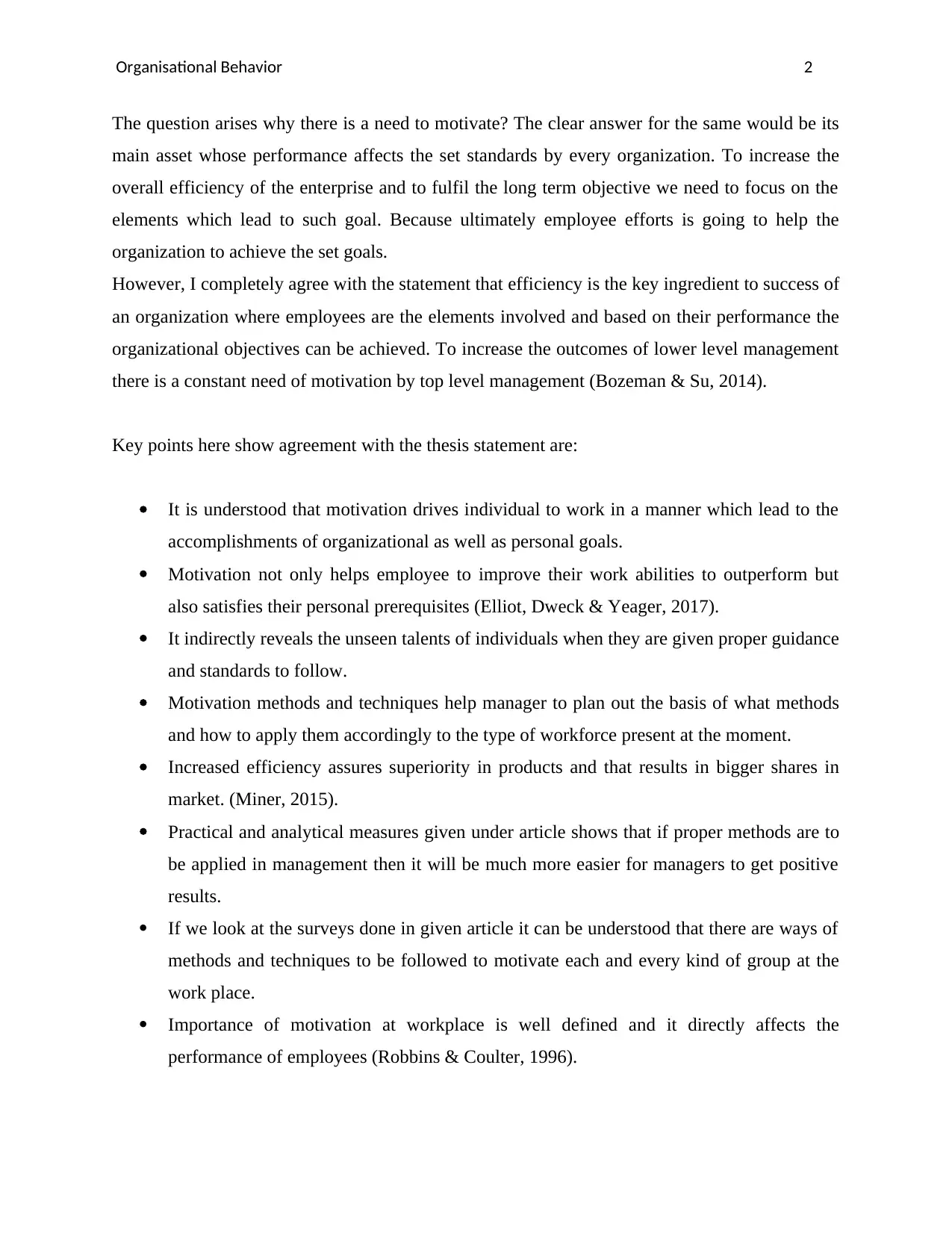
Organisational Behavior 2
The question arises why there is a need to motivate? The clear answer for the same would be its
main asset whose performance affects the set standards by every organization. To increase the
overall efficiency of the enterprise and to fulfil the long term objective we need to focus on the
elements which lead to such goal. Because ultimately employee efforts is going to help the
organization to achieve the set goals.
However, I completely agree with the statement that efficiency is the key ingredient to success of
an organization where employees are the elements involved and based on their performance the
organizational objectives can be achieved. To increase the outcomes of lower level management
there is a constant need of motivation by top level management (Bozeman & Su, 2014).
Key points here show agreement with the thesis statement are:
It is understood that motivation drives individual to work in a manner which lead to the
accomplishments of organizational as well as personal goals.
Motivation not only helps employee to improve their work abilities to outperform but
also satisfies their personal prerequisites (Elliot, Dweck & Yeager, 2017).
It indirectly reveals the unseen talents of individuals when they are given proper guidance
and standards to follow.
Motivation methods and techniques help manager to plan out the basis of what methods
and how to apply them accordingly to the type of workforce present at the moment.
Increased efficiency assures superiority in products and that results in bigger shares in
market. (Miner, 2015).
Practical and analytical measures given under article shows that if proper methods are to
be applied in management then it will be much more easier for managers to get positive
results.
If we look at the surveys done in given article it can be understood that there are ways of
methods and techniques to be followed to motivate each and every kind of group at the
work place.
Importance of motivation at workplace is well defined and it directly affects the
performance of employees (Robbins & Coulter, 1996).
The question arises why there is a need to motivate? The clear answer for the same would be its
main asset whose performance affects the set standards by every organization. To increase the
overall efficiency of the enterprise and to fulfil the long term objective we need to focus on the
elements which lead to such goal. Because ultimately employee efforts is going to help the
organization to achieve the set goals.
However, I completely agree with the statement that efficiency is the key ingredient to success of
an organization where employees are the elements involved and based on their performance the
organizational objectives can be achieved. To increase the outcomes of lower level management
there is a constant need of motivation by top level management (Bozeman & Su, 2014).
Key points here show agreement with the thesis statement are:
It is understood that motivation drives individual to work in a manner which lead to the
accomplishments of organizational as well as personal goals.
Motivation not only helps employee to improve their work abilities to outperform but
also satisfies their personal prerequisites (Elliot, Dweck & Yeager, 2017).
It indirectly reveals the unseen talents of individuals when they are given proper guidance
and standards to follow.
Motivation methods and techniques help manager to plan out the basis of what methods
and how to apply them accordingly to the type of workforce present at the moment.
Increased efficiency assures superiority in products and that results in bigger shares in
market. (Miner, 2015).
Practical and analytical measures given under article shows that if proper methods are to
be applied in management then it will be much more easier for managers to get positive
results.
If we look at the surveys done in given article it can be understood that there are ways of
methods and techniques to be followed to motivate each and every kind of group at the
work place.
Importance of motivation at workplace is well defined and it directly affects the
performance of employees (Robbins & Coulter, 1996).
⊘ This is a preview!⊘
Do you want full access?
Subscribe today to unlock all pages.

Trusted by 1+ million students worldwide
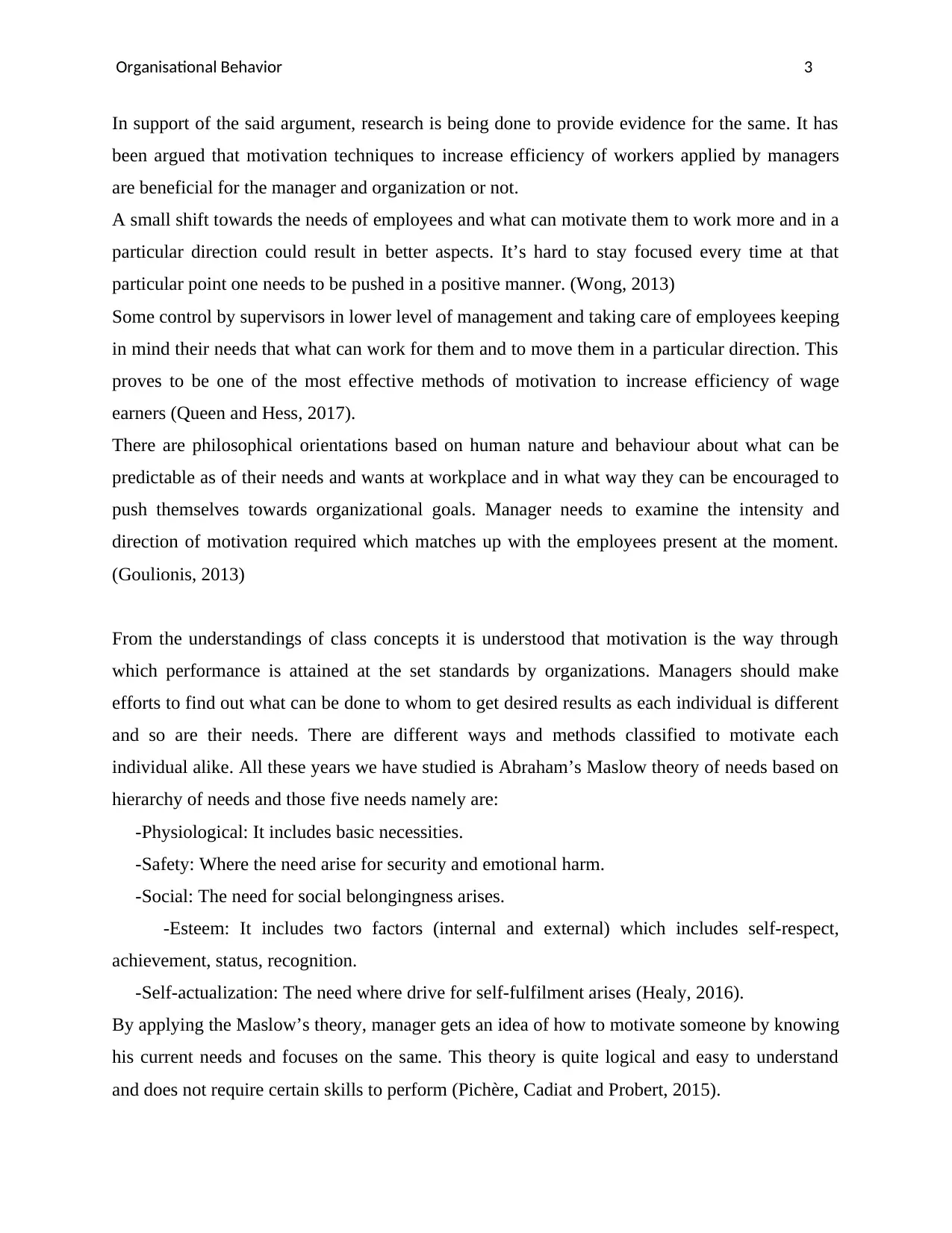
Organisational Behavior 3
In support of the said argument, research is being done to provide evidence for the same. It has
been argued that motivation techniques to increase efficiency of workers applied by managers
are beneficial for the manager and organization or not.
A small shift towards the needs of employees and what can motivate them to work more and in a
particular direction could result in better aspects. It’s hard to stay focused every time at that
particular point one needs to be pushed in a positive manner. (Wong, 2013)
Some control by supervisors in lower level of management and taking care of employees keeping
in mind their needs that what can work for them and to move them in a particular direction. This
proves to be one of the most effective methods of motivation to increase efficiency of wage
earners (Queen and Hess, 2017).
There are philosophical orientations based on human nature and behaviour about what can be
predictable as of their needs and wants at workplace and in what way they can be encouraged to
push themselves towards organizational goals. Manager needs to examine the intensity and
direction of motivation required which matches up with the employees present at the moment.
(Goulionis, 2013)
From the understandings of class concepts it is understood that motivation is the way through
which performance is attained at the set standards by organizations. Managers should make
efforts to find out what can be done to whom to get desired results as each individual is different
and so are their needs. There are different ways and methods classified to motivate each
individual alike. All these years we have studied is Abraham’s Maslow theory of needs based on
hierarchy of needs and those five needs namely are:
-Physiological: It includes basic necessities.
-Safety: Where the need arise for security and emotional harm.
-Social: The need for social belongingness arises.
-Esteem: It includes two factors (internal and external) which includes self-respect,
achievement, status, recognition.
-Self-actualization: The need where drive for self-fulfilment arises (Healy, 2016).
By applying the Maslow’s theory, manager gets an idea of how to motivate someone by knowing
his current needs and focuses on the same. This theory is quite logical and easy to understand
and does not require certain skills to perform (Pichère, Cadiat and Probert, 2015).
In support of the said argument, research is being done to provide evidence for the same. It has
been argued that motivation techniques to increase efficiency of workers applied by managers
are beneficial for the manager and organization or not.
A small shift towards the needs of employees and what can motivate them to work more and in a
particular direction could result in better aspects. It’s hard to stay focused every time at that
particular point one needs to be pushed in a positive manner. (Wong, 2013)
Some control by supervisors in lower level of management and taking care of employees keeping
in mind their needs that what can work for them and to move them in a particular direction. This
proves to be one of the most effective methods of motivation to increase efficiency of wage
earners (Queen and Hess, 2017).
There are philosophical orientations based on human nature and behaviour about what can be
predictable as of their needs and wants at workplace and in what way they can be encouraged to
push themselves towards organizational goals. Manager needs to examine the intensity and
direction of motivation required which matches up with the employees present at the moment.
(Goulionis, 2013)
From the understandings of class concepts it is understood that motivation is the way through
which performance is attained at the set standards by organizations. Managers should make
efforts to find out what can be done to whom to get desired results as each individual is different
and so are their needs. There are different ways and methods classified to motivate each
individual alike. All these years we have studied is Abraham’s Maslow theory of needs based on
hierarchy of needs and those five needs namely are:
-Physiological: It includes basic necessities.
-Safety: Where the need arise for security and emotional harm.
-Social: The need for social belongingness arises.
-Esteem: It includes two factors (internal and external) which includes self-respect,
achievement, status, recognition.
-Self-actualization: The need where drive for self-fulfilment arises (Healy, 2016).
By applying the Maslow’s theory, manager gets an idea of how to motivate someone by knowing
his current needs and focuses on the same. This theory is quite logical and easy to understand
and does not require certain skills to perform (Pichère, Cadiat and Probert, 2015).
Paraphrase This Document
Need a fresh take? Get an instant paraphrase of this document with our AI Paraphraser
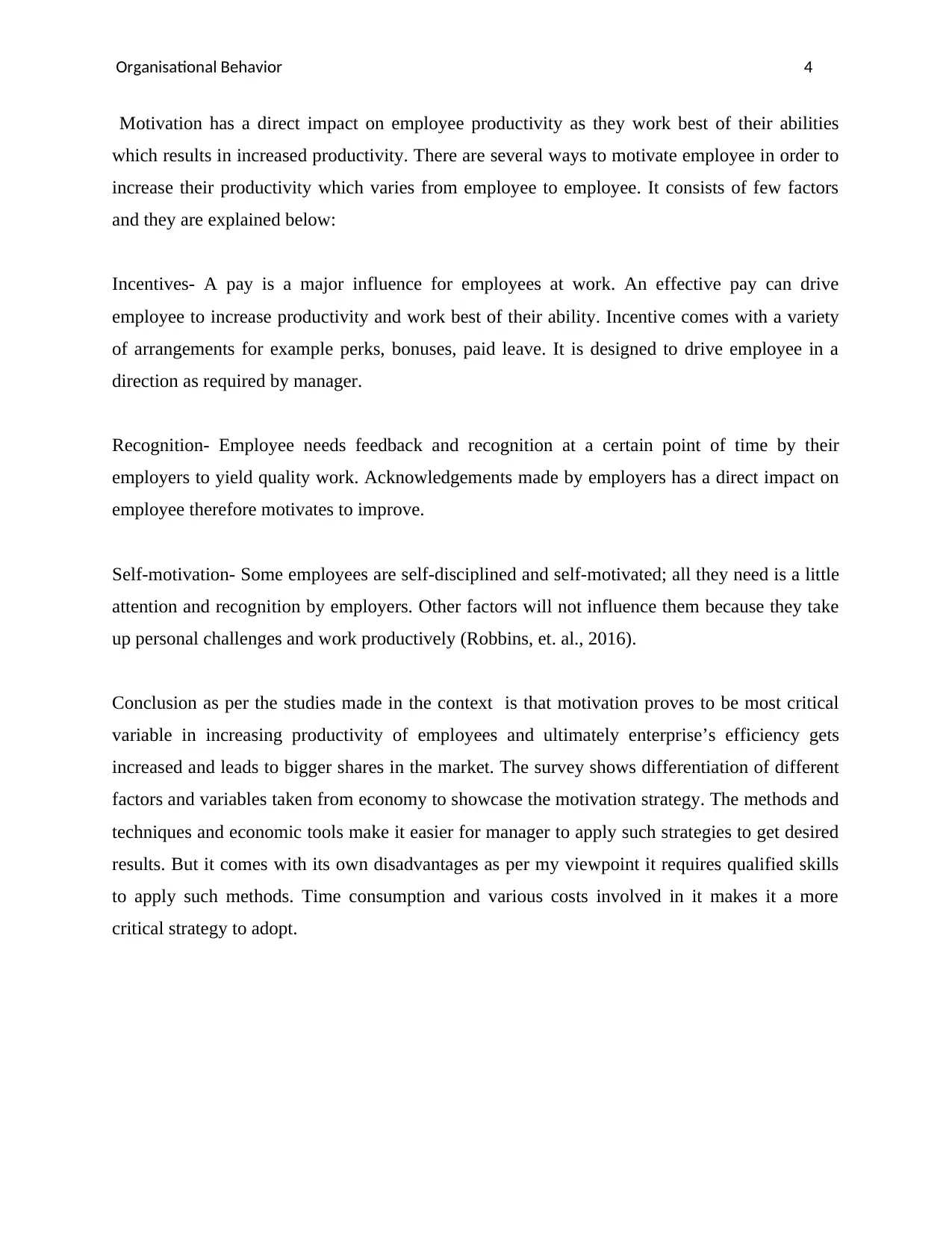
Organisational Behavior 4
Motivation has a direct impact on employee productivity as they work best of their abilities
which results in increased productivity. There are several ways to motivate employee in order to
increase their productivity which varies from employee to employee. It consists of few factors
and they are explained below:
Incentives- A pay is a major influence for employees at work. An effective pay can drive
employee to increase productivity and work best of their ability. Incentive comes with a variety
of arrangements for example perks, bonuses, paid leave. It is designed to drive employee in a
direction as required by manager.
Recognition- Employee needs feedback and recognition at a certain point of time by their
employers to yield quality work. Acknowledgements made by employers has a direct impact on
employee therefore motivates to improve.
Self-motivation- Some employees are self-disciplined and self-motivated; all they need is a little
attention and recognition by employers. Other factors will not influence them because they take
up personal challenges and work productively (Robbins, et. al., 2016).
Conclusion as per the studies made in the context is that motivation proves to be most critical
variable in increasing productivity of employees and ultimately enterprise’s efficiency gets
increased and leads to bigger shares in the market. The survey shows differentiation of different
factors and variables taken from economy to showcase the motivation strategy. The methods and
techniques and economic tools make it easier for manager to apply such strategies to get desired
results. But it comes with its own disadvantages as per my viewpoint it requires qualified skills
to apply such methods. Time consumption and various costs involved in it makes it a more
critical strategy to adopt.
Motivation has a direct impact on employee productivity as they work best of their abilities
which results in increased productivity. There are several ways to motivate employee in order to
increase their productivity which varies from employee to employee. It consists of few factors
and they are explained below:
Incentives- A pay is a major influence for employees at work. An effective pay can drive
employee to increase productivity and work best of their ability. Incentive comes with a variety
of arrangements for example perks, bonuses, paid leave. It is designed to drive employee in a
direction as required by manager.
Recognition- Employee needs feedback and recognition at a certain point of time by their
employers to yield quality work. Acknowledgements made by employers has a direct impact on
employee therefore motivates to improve.
Self-motivation- Some employees are self-disciplined and self-motivated; all they need is a little
attention and recognition by employers. Other factors will not influence them because they take
up personal challenges and work productively (Robbins, et. al., 2016).
Conclusion as per the studies made in the context is that motivation proves to be most critical
variable in increasing productivity of employees and ultimately enterprise’s efficiency gets
increased and leads to bigger shares in the market. The survey shows differentiation of different
factors and variables taken from economy to showcase the motivation strategy. The methods and
techniques and economic tools make it easier for manager to apply such strategies to get desired
results. But it comes with its own disadvantages as per my viewpoint it requires qualified skills
to apply such methods. Time consumption and various costs involved in it makes it a more
critical strategy to adopt.
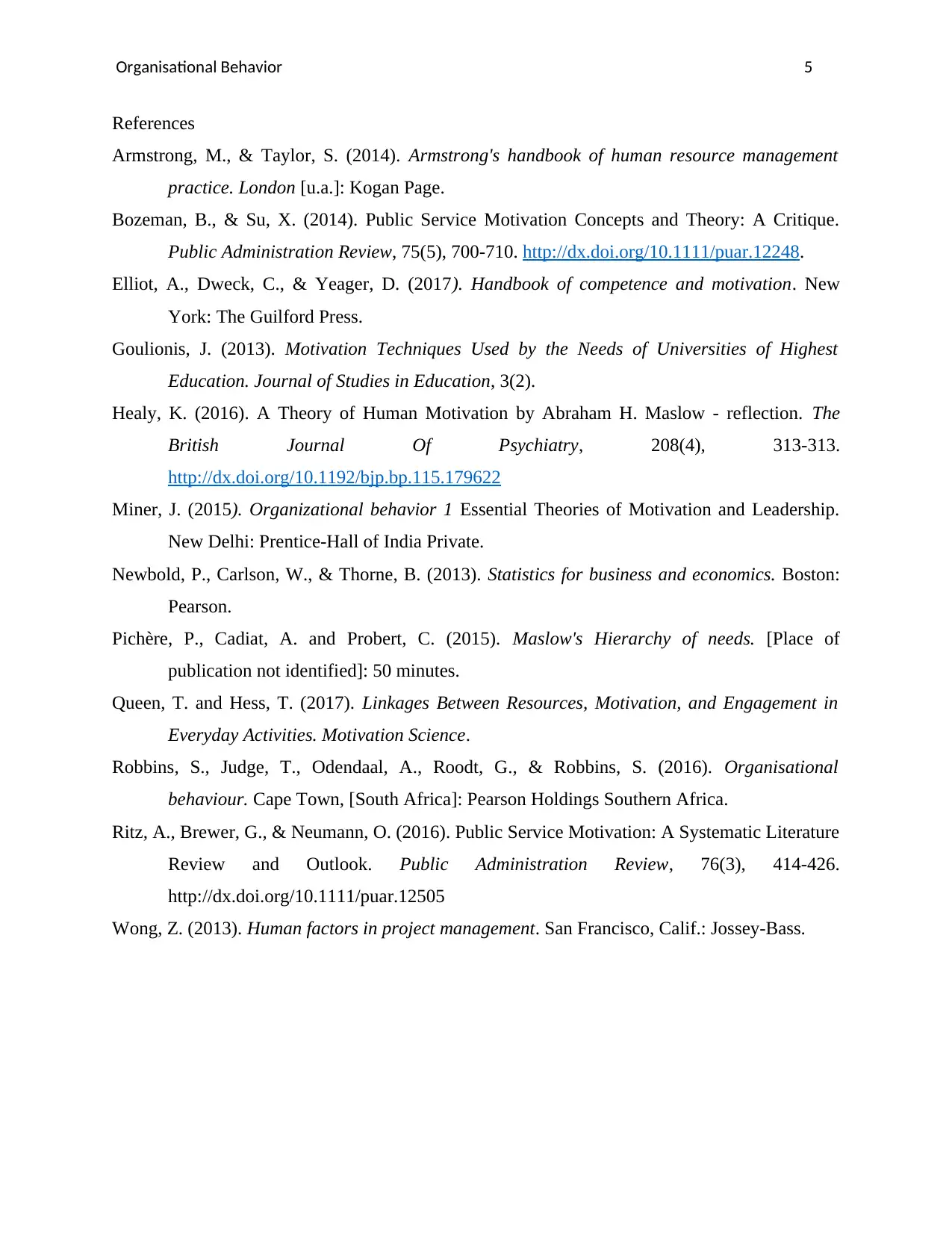
Organisational Behavior 5
References
Armstrong, M., & Taylor, S. (2014). Armstrong's handbook of human resource management
practice. London [u.a.]: Kogan Page.
Bozeman, B., & Su, X. (2014). Public Service Motivation Concepts and Theory: A Critique.
Public Administration Review, 75(5), 700-710. http://dx.doi.org/10.1111/puar.12248.
Elliot, A., Dweck, C., & Yeager, D. (2017). Handbook of competence and motivation. New
York: The Guilford Press.
Goulionis, J. (2013). Motivation Techniques Used by the Needs of Universities of Highest
Education. Journal of Studies in Education, 3(2).
Healy, K. (2016). A Theory of Human Motivation by Abraham H. Maslow - reflection. The
British Journal Of Psychiatry, 208(4), 313-313.
http://dx.doi.org/10.1192/bjp.bp.115.179622
Miner, J. (2015). Organizational behavior 1 Essential Theories of Motivation and Leadership.
New Delhi: Prentice-Hall of India Private.
Newbold, P., Carlson, W., & Thorne, B. (2013). Statistics for business and economics. Boston:
Pearson.
Pichère, P., Cadiat, A. and Probert, C. (2015). Maslow's Hierarchy of needs. [Place of
publication not identified]: 50 minutes.
Queen, T. and Hess, T. (2017). Linkages Between Resources, Motivation, and Engagement in
Everyday Activities. Motivation Science.
Robbins, S., Judge, T., Odendaal, A., Roodt, G., & Robbins, S. (2016). Organisational
behaviour. Cape Town, [South Africa]: Pearson Holdings Southern Africa.
Ritz, A., Brewer, G., & Neumann, O. (2016). Public Service Motivation: A Systematic Literature
Review and Outlook. Public Administration Review, 76(3), 414-426.
http://dx.doi.org/10.1111/puar.12505
Wong, Z. (2013). Human factors in project management. San Francisco, Calif.: Jossey-Bass.
References
Armstrong, M., & Taylor, S. (2014). Armstrong's handbook of human resource management
practice. London [u.a.]: Kogan Page.
Bozeman, B., & Su, X. (2014). Public Service Motivation Concepts and Theory: A Critique.
Public Administration Review, 75(5), 700-710. http://dx.doi.org/10.1111/puar.12248.
Elliot, A., Dweck, C., & Yeager, D. (2017). Handbook of competence and motivation. New
York: The Guilford Press.
Goulionis, J. (2013). Motivation Techniques Used by the Needs of Universities of Highest
Education. Journal of Studies in Education, 3(2).
Healy, K. (2016). A Theory of Human Motivation by Abraham H. Maslow - reflection. The
British Journal Of Psychiatry, 208(4), 313-313.
http://dx.doi.org/10.1192/bjp.bp.115.179622
Miner, J. (2015). Organizational behavior 1 Essential Theories of Motivation and Leadership.
New Delhi: Prentice-Hall of India Private.
Newbold, P., Carlson, W., & Thorne, B. (2013). Statistics for business and economics. Boston:
Pearson.
Pichère, P., Cadiat, A. and Probert, C. (2015). Maslow's Hierarchy of needs. [Place of
publication not identified]: 50 minutes.
Queen, T. and Hess, T. (2017). Linkages Between Resources, Motivation, and Engagement in
Everyday Activities. Motivation Science.
Robbins, S., Judge, T., Odendaal, A., Roodt, G., & Robbins, S. (2016). Organisational
behaviour. Cape Town, [South Africa]: Pearson Holdings Southern Africa.
Ritz, A., Brewer, G., & Neumann, O. (2016). Public Service Motivation: A Systematic Literature
Review and Outlook. Public Administration Review, 76(3), 414-426.
http://dx.doi.org/10.1111/puar.12505
Wong, Z. (2013). Human factors in project management. San Francisco, Calif.: Jossey-Bass.
⊘ This is a preview!⊘
Do you want full access?
Subscribe today to unlock all pages.

Trusted by 1+ million students worldwide
1 out of 6
Related Documents
Your All-in-One AI-Powered Toolkit for Academic Success.
+13062052269
info@desklib.com
Available 24*7 on WhatsApp / Email
![[object Object]](/_next/static/media/star-bottom.7253800d.svg)
Unlock your academic potential
Copyright © 2020–2025 A2Z Services. All Rights Reserved. Developed and managed by ZUCOL.





